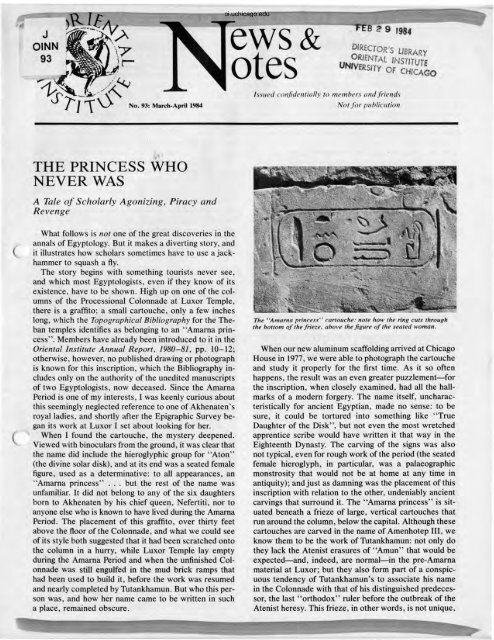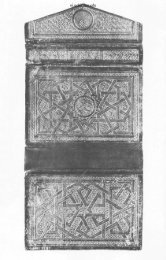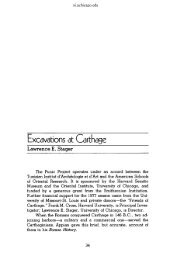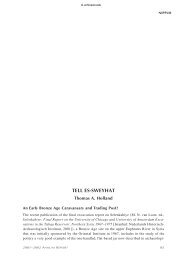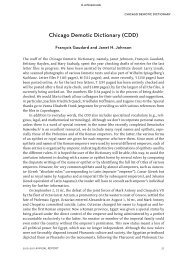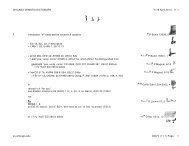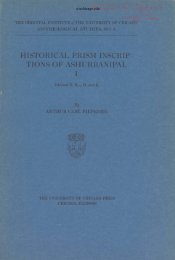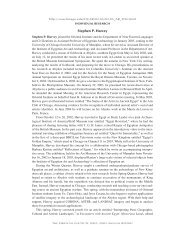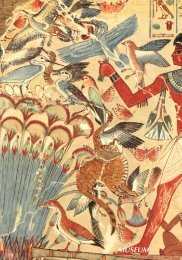ews& otes - Oriental Institute - University of Chicago
ews& otes - Oriental Institute - University of Chicago
ews& otes - Oriental Institute - University of Chicago
You also want an ePaper? Increase the reach of your titles
YUMPU automatically turns print PDFs into web optimized ePapers that Google loves.
ews&<br />
<strong>otes</strong><br />
oi.uchicago.edu<br />
B 9 '984<br />
DIRECTOR'S LIBRARY<br />
ORIENTAL INSTITUTE<br />
UNIVERSITY OF CHICAGO<br />
Issued confidentially to members and friends<br />
Not f or pllblication<br />
THE PRINCESS WHO<br />
NEVER WAS<br />
A Tale <strong>of</strong> Scholarly Agonizing, Piracy and<br />
Revenge<br />
What follows is not one <strong>of</strong> the great discoveries in the<br />
annals <strong>of</strong> Egyptology. But it makes a diverting story, and<br />
it illustrates how scholars sometimes have to use a jackhammer<br />
to squash a fly.<br />
The story begins with something tourists never see,<br />
and which most Egyptologists, even if they know <strong>of</strong> its<br />
existence, have to be shown. High up on one <strong>of</strong> the columns<br />
<strong>of</strong> the Processional Colonnade at Luxor Temple,<br />
there is a graffito: a small cartouche, only a few inches<br />
long, which the Topographical Bibliography for the Theban<br />
temples identifies as belonging to an "Amarna princess".<br />
Members have already been introduced to it in the<br />
<strong>Oriental</strong> <strong>Institute</strong> Annual R eport, 1980-81, pp. 10-12;<br />
otherwise, however, no published drawing or photograph<br />
is known for this inscription, which the Bibliography includes<br />
only on the authority <strong>of</strong> the unedited manuscripts<br />
<strong>of</strong> two Egyptologists, now deceased. Since the Amarna<br />
Period is one <strong>of</strong> my interests, I was keenly curious about<br />
this seemingly neglected reference to one <strong>of</strong> Akhenaten's<br />
royal ladies, and shortly after the Epigraphic Survey began<br />
its work at Luxor I set about looking for her.<br />
When I found the cartouche, the mystery deepened.<br />
Viewed with binoculars from the ground, it was clear that<br />
the name did include the hieroglyphic group for "Aton"<br />
(the divine solar disk), and at its end was a seated female<br />
figure, used as a determinative: to all appearances, an<br />
"Amarna princess" . . . but the rest <strong>of</strong> the name was<br />
unfamiliar. It did not belong to any <strong>of</strong> the six daughters<br />
born to Akhenaten by his chief queen, Nefertiti, nor to<br />
anyone else who is known to have lived during the Amarna<br />
Period. The placement <strong>of</strong> this graffito, over thirty feet<br />
above the floor <strong>of</strong> the Colonnade, and what we could see<br />
<strong>of</strong> its style both suggested that it had been scratched onto<br />
the column in a hurry, while Luxor Temple lay empty<br />
during the Amarna Period and when the unfinished Colonnade<br />
was still engulfed in the mud brick ramps that<br />
had been used to build it, before the work was resumed<br />
and nearly completed by Tutankhamun. But who this person<br />
was, and how her name came to be written in such<br />
a place, remained obscure.<br />
The "A marna princess" cartouche: note how the ring cuts through<br />
the bottom <strong>of</strong> the frieze. above the figure <strong>of</strong> the seated woman.<br />
When our new aluminum scaffolding arrived at <strong>Chicago</strong><br />
House in 1977, we were able to photograph the cartouche<br />
and study it properly for the first time. As it so <strong>of</strong>ten<br />
happens, the result was an even greater puzzlement-for<br />
the inscription, when closely e.xamined, had all the hallmarks<br />
<strong>of</strong> a modern forgery. The name itself, uncharacteristically<br />
for ancient Egyptian, made no sense: to be<br />
sure, it could be tortured into something like " True<br />
Daughter <strong>of</strong> the Disk", but not even the most wretched<br />
apprentice scribe would have written it that way in the<br />
Eighteenth Dynasty. The carving <strong>of</strong> the signs was also<br />
not typical, even for rough work <strong>of</strong> the period (the seated<br />
female hieroglyph, in particular, was a palaeographic<br />
monstrosity that would not be at home at any time in<br />
antiquity); and just as damning was the placement <strong>of</strong> this<br />
inscription with relation to the other, undeniably ancient<br />
carvings that surround it. The "Amarna princess" is situated<br />
beneath a frieze <strong>of</strong> large, vertical cartouches that<br />
run around the column, below the capital. Although these<br />
cartouches are carved in the name <strong>of</strong> Amenhotep III, we<br />
know them to be the work <strong>of</strong> Tutankhamun: not only do<br />
they lack the Atenist erasures <strong>of</strong> "Amun" that would be<br />
expected-and, indeed, are normal-in the pre-Amarna<br />
material at Luxor; but they also form part <strong>of</strong> a conspicuous<br />
tendency <strong>of</strong> Tutankhamun's to associate his name<br />
in the Colonnade with that <strong>of</strong> his distinguished predecessor,<br />
the last "orthodox" ruler before the outbreak <strong>of</strong> the<br />
Atenist heresy. This frieze, in other words, is not unique,
oi.uchicago.edu<br />
and it is clearly post-Amarna in date-so it was disturbing<br />
to find the supposed earlier cartouche <strong>of</strong> the "Amarna<br />
princess" cutting through the lower elements <strong>of</strong> the later<br />
frieze in a way that would have surely resulted in the<br />
partial obliteration <strong>of</strong> any earlier carvings once the wall 's<br />
surface had been smoothed down to form the background<br />
<strong>of</strong> the later bas-relief frieze. By all the criteria <strong>of</strong> our<br />
training and experience, then, the ' 'Amarna princess" had<br />
to be a fraud: her authenticity could only be upheld by<br />
the sort <strong>of</strong> special pleading we prefer not to use in our<br />
scientific work.<br />
So, why were we still puzzled? Modern graffiti abound<br />
in the Colonnade-where we have systematically collected<br />
them-and many are found high up on the columns,<br />
placed there by visitors in the Nineteenth Century, when<br />
the hall was still buried under the debris <strong>of</strong> millennia.<br />
What made this graffito different was that it was said to<br />
have been seen by Ipolitto Rosellini, Champollion's student<br />
and colleague, who had accompanied the decipherer<br />
<strong>of</strong> the hieroglyphs through Egypt and Nubia in 1828/29.<br />
And therein lies the puzzle. If the "Amarna princess"<br />
was seen by Rosellini, her cartouche must have been<br />
inscribed no later than 1829, barely seven years after the<br />
decipherment <strong>of</strong> the hieroglyphs. The first Egyptologists<br />
might well have spent an idle moment putting their friends'<br />
names into Egyptian (Champollion, we know, certainly<br />
did); but a transcription <strong>of</strong> the signs in the cartouche into<br />
their modern alphabetic values did not suggest the name<br />
<strong>of</strong> anyone on Rosellini's expedition-or, indeed, anyone<br />
or anything else that would have been relevant back in<br />
the infant days <strong>of</strong> Egyptology. Moreover, although Champoll<br />
ion and Rosellini visited EI Amarna, they brought<br />
relatively little away from that site, and there is no reason<br />
to believe that what they saw there made much <strong>of</strong> an<br />
impression. Certainly neither <strong>of</strong> these scholars, working<br />
at the dawn <strong>of</strong> Egyptological science, made much <strong>of</strong> the<br />
Atenist heresy: Rosellini, in fact, even though he had a<br />
good grasp <strong>of</strong> the royal succession <strong>of</strong> the Eighteenth Dynasty<br />
up to and including Amenhotep III, did not even<br />
include Akhenaten in his reconstruction <strong>of</strong> the period,<br />
but relegated him to somewhere in the dark ages <strong>of</strong> before<br />
the Fifteenth Dynasty-clear pro<strong>of</strong> that Rosellini did not<br />
know what to do with Akhenaten and had no idea <strong>of</strong> his<br />
importance. This made the "Atenist" form <strong>of</strong> the name<br />
all the more perplexing-for who would forge such a thing<br />
in 1829, when the Amarna Period was not even suspected,<br />
let alone controversial? On such slender grounds rested<br />
the last desperate possibility that the "A marna princess"<br />
might, after all, be ancient.<br />
It was only after we had tracked down our sources that<br />
the fog began to lift. Through the courtesy <strong>of</strong> the Centre<br />
Documentaire de I'Histoire des Religions in Paris, we<br />
were able to verify the sighting by the French Egyptologist<br />
Pierre Lacau, who saw the "Amarna princess" in<br />
the earlier Twentieth Century. But the crucial breakthrough<br />
was made possible by two other friends, Pr<strong>of</strong>essor<br />
Edda Bresciani <strong>of</strong> the <strong>University</strong> <strong>of</strong> Pisa and Dr. Jaromfr<br />
Malek, editor <strong>of</strong> the Topographical Bibliography,<br />
at the Griffith <strong>Institute</strong> in Oxford. From their checking<br />
<strong>of</strong> files and original documents, it emerged that the Rosellini<br />
reference was one <strong>of</strong> those unfortunate mistakes<br />
that can creep into any serious undertaking <strong>of</strong> any magnitude.<br />
In brief, it was a red herring: the "Amarna princess"<br />
appears nowhere in Rosellini's papers, and with<br />
that early "sighting" now eliminated, we had a wider and<br />
more realistic period in which to look for the perpetrator<br />
<strong>of</strong> this apparent hoax. Happily, the result is something<br />
that goes some <strong>of</strong> the way towards justifying the time and<br />
effort we had already spent on it. Given the location <strong>of</strong><br />
the "Amarna princess" , so high <strong>of</strong>f the ground, it was a<br />
fair bet that it was not carved after 1889, when we know<br />
the Colonnade was cleared down to its floor. Whoever<br />
carved this graffito must have had a grounding in Egyptian<br />
language, based on the grammars and dictionaries available<br />
up to that time. We already knew how Champollion<br />
would have read the name. Making a fresh transcription<br />
which incorporated the values given to the signs by such<br />
later authorities as Brugsch and Pierret was easily done,<br />
and yielded the following:<br />
NE-T/D-N S-MNME-TH<br />
The ''Amarna princess" in context: see black arrow.<br />
This gave us the skeleton <strong>of</strong> a name, "Aton" or "Edon<br />
Smath". Even so, this is not a strict phonological equivalent<br />
for any orthodox name; but if we allow for the<br />
distortion that would result from the author's attempt to<br />
write his name in a mongrel " Egyptian", using common<br />
words such as that for the sun's disk, what we have is a<br />
recognizable name in English. I now firmly believe that<br />
we can identify its owner as none other than "Edwin<br />
Smith".<br />
The name <strong>of</strong> Edwin Smith will not be unknown to members<br />
<strong>of</strong> the <strong>Oriental</strong> <strong>Institute</strong>, and he fills rather well the<br />
specifications one would imagine for the author <strong>of</strong> this
oi.uchicago.edu<br />
hitherto puzzling cartouche. One <strong>of</strong> scholarship's soldiers<br />
<strong>of</strong> fortune, he was one <strong>of</strong> the earliest specialists in the<br />
study <strong>of</strong> the cursive hieratic script, excelling in this many<br />
<strong>of</strong> his more eminent contemporaries. But there was a<br />
darker side to Smith's nature as well, one that was very<br />
probably abetted by the unconventional circumstances in<br />
which he chose to live. Readers who want to know more<br />
about him than I can tell here may go to the introduction<br />
<strong>of</strong> James Henry Breasted's Th e Edwin Smith Surgical<br />
Papyrus, Vol. I (<strong>Chicago</strong>, 1930), pp. 20-25, and to John<br />
A. Wilson's history <strong>of</strong> American Egyptology, Signs and<br />
Wonders upon Pharaoh (<strong>Chicago</strong>, 1964), pp. 52-57. In<br />
brief, Smith was an American who, having studied Egyptology<br />
in London and Paris, came during the 1850's to<br />
live in Luxor, where he stayed until about 1876. He supported<br />
himself as a money lender, also selling antikkas<strong>of</strong><br />
both the genuine and forged varieties-to European<br />
tourists. Though himself a tireless worker, Smith never<br />
published anything, and his few surviving letters reveal<br />
the workings <strong>of</strong> a powerful but undisciplined erudition.<br />
Contemporaries regarded him as something <strong>of</strong> an eccentric,<br />
respect for his genuine scholarly attainments being<br />
overshadowed by the bemusement or outright distrust<br />
which his uncommon lifestyle inspired.<br />
Edwin Smith's connection to <strong>Chicago</strong> goes back, in the<br />
first instance, to Breasted's publication <strong>of</strong> the ancient<br />
surgical treatise that bears Smith's name. Most recently,<br />
he comes to our attention not only as the likely author<br />
<strong>of</strong> the "Amarna princess", but also because <strong>of</strong> his association<br />
with another important figure in the Luxor Colonnade's<br />
history before its excavation, Mustapha Agha<br />
Ayat. Members will also have read about him in past<br />
Annual Reports. For many years the consular agent for<br />
England, Belgium and Russia, Mustapha was a well-known<br />
figure in Luxor and, like many other Egyptians who dealt<br />
with foreigners on a regular basis, he was a prominent<br />
dealer in antiquities. He lived in an imposing house, built<br />
early in the 1850's against three <strong>of</strong> the eastern columns<br />
in the Luxor Colonnade (one <strong>of</strong> which is the very column<br />
on which the "A marna princess" is found): indeed, on<br />
the evidence <strong>of</strong> contemporary photographs, the spot where<br />
this graffito was carved would have been within easy reach<br />
from the ground in front <strong>of</strong> Mustapha's house. It comes<br />
as no surprise to learn that Edwin Smith and Mustapha<br />
Agha knew one another for most, if not all <strong>of</strong> the period<br />
that Smith lived in Luxor. Smith, in fact, lived in Mustapha's<br />
house, bought antiquities from him (including the<br />
famous " Edwin Smith Surgical Papyrus"), and helped<br />
him arrange entertainments for such notable visitors as<br />
the Prince <strong>of</strong> Wales. In effect, the two men were partners.<br />
Smith's financial dealings, I suspect, provided the capital<br />
and Mustapha's local connections the contacts for a highly<br />
pr<strong>of</strong>itable business which allowed Smith to acquire a store<br />
<strong>of</strong> interesting and saleable antiquities.<br />
Smith's and Mustapha's biggest coup came in connection<br />
with the sale <strong>of</strong> a large medical papyrus (not the<br />
surgical treatise published by Breasted, but a much larger<br />
work) which Smith had in his possession for many years.<br />
Travelling scholars in Luxor were regaled , not only with<br />
Smith's collection <strong>of</strong>forged scarabs, but with tantalizing<br />
glimpses <strong>of</strong> his hieratic papyri. Smith was by no means<br />
unaware <strong>of</strong> what he owned: it was he who called his<br />
visitors' attention to one <strong>of</strong> the curiosities <strong>of</strong> his great<br />
medical papyrus, the festival calendar it contained; and<br />
it was he who supplied them with the tracings from which<br />
were made the first publications <strong>of</strong> this section, the proper<br />
interpretation <strong>of</strong> which has bedeviled Egyptology ever<br />
since. The scholar in Edwin Smith did not want to sell<br />
this document: he preferred to keep and study it. But<br />
"Papyrus Smith" (as it was now coming to be known)<br />
had attracted the interest <strong>of</strong> the formidable German Egyptologist,<br />
Georg Ebers. Not only did Ebers covet the document<br />
for German scholarship, he also was desperately<br />
eager to have it known as "Papyrus Ebers"-and since,<br />
by tradition, papyri were named after their first non-Egyptian<br />
owners, Ebers had to secure not only the papyrus<br />
itself, but also his claim against Edwin Smith's prior ownership<br />
<strong>of</strong> it.<br />
He succeeded in doing both in 1872. By this time, Luxor<br />
was no longer so comfortable for Edwin Smith: he was<br />
The Processional Colonnade <strong>of</strong> Luxor Temple, from the top <strong>of</strong> the<br />
Pylon: the ''Amarna princess" graffito is located on the fifth column<br />
from the left, in the back row, facing southeast.<br />
A view <strong>of</strong> Mustapha Agha's house, with its porch <strong>of</strong> sugarcane<br />
stalks, in the Luxor Colonnade during the third quarter <strong>of</strong> the Nineteenth<br />
Century.
'1'I'~~ .:~ ~ .~"""H " "";";;;:~""~~ ' ti," :·:'i;"· ;_ .· '~1~'.i.->~· ¥4'~.'~_~..;.$';"':.'~';:(·~'·~;;"'Ji·,"'"""'.,"" ... .;[;.. "',.k"",." ~~"' ..'··
oi.uchicago.edu<br />
INSTITUTE PROFESSOR IS NEW HEAD OF SMITHSONIAN<br />
Robert McC . Adams, twice Director <strong>of</strong> the <strong>Oriental</strong> <strong>Institute</strong><br />
and currently Provost <strong>of</strong> the <strong>University</strong> <strong>of</strong> <strong>Chicago</strong>,<br />
will become the Secretary <strong>of</strong> the Smithsonian Institution<br />
in Washington in September. Replacing the<br />
current Secretary, S. Dillon Ripley, Adams will become<br />
the ninth Secretary since the Smithsonian's founding 137<br />
years ago.<br />
Adams has been on the faculty <strong>of</strong> the <strong>University</strong> <strong>of</strong> <strong>Chicago</strong><br />
since 1955 , after receiving his Ph.B. , A.M. , and<br />
Ph.D. from the <strong>University</strong>. He was Director <strong>of</strong> the <strong>Oriental</strong><br />
<strong>Institute</strong> from 1962 to 1968 and from 1981 to 1983<br />
and is the Harold H. Swift Distinguished Service Pr<strong>of</strong>essor<br />
in the <strong>Oriental</strong> <strong>Institute</strong> and the Departments <strong>of</strong> Anthropology<br />
and Near Eastern Languages and Civilizations<br />
. An authority on the urban and agricultural history<br />
<strong>of</strong> the Near East, Adams has made extensive archaeological<br />
studies <strong>of</strong> settlement patterns and the comparative<br />
social and economic history <strong>of</strong> pre-modern societies .<br />
THE SUQ<br />
..<br />
U.-J-<br />
..,.JI<br />
R obert McCormick Adams<br />
JARMO FERTILITY FIGURE<br />
Replica <strong>of</strong> a fertility figure (ca. 6750 B.C.) found at Jarmo,<br />
Robert and Linda Braidwood's <strong>Oriental</strong> <strong>Institute</strong> excavation<br />
in Iraq.<br />
Made <strong>of</strong> a white resin, figure stands 1112 inches high.<br />
Figure is available from The Suq at $7.00 each minus a<br />
10% discount for members. Please add 8% sales tax for<br />
shipping in Illinois plus · .50 postage and handling for each<br />
figurine .<br />
DOCENT TRAINING<br />
CLASSES TO BE HELD IN<br />
APRIL<br />
Members wiU be interested to know that we have a few<br />
vacancies for volunteer guides in the Museum.<br />
The 8-week training program will begin on Monday,<br />
April 2 and will meet on the following 4 Mondays. The<br />
last three classes will be held on Saturdays.<br />
The program which lasts from 9:30 to 2: 15 consists <strong>of</strong><br />
lectures by the faculty <strong>of</strong> the <strong>Oriental</strong> <strong>Institute</strong>, movies<br />
and gallery workshops conducted by the Educational Coordinator<br />
and the Docent Chairmen, past and present.<br />
If accepted in the program, the prospective docent must<br />
be willing to serve as a Museum guide a half a day a week.<br />
In addition to the regular membership in the <strong>Oriental</strong><br />
<strong>Institute</strong>, a one-time fee <strong>of</strong> $25.00 is charged for a Docent<br />
Kit <strong>of</strong> materials as well as a copy <strong>of</strong> the Guide to the<br />
<strong>Oriental</strong> <strong>Institute</strong> Museum.<br />
For those not able to come on Mondays, a Saturday<br />
seminar beginning on April 7 may be held. Weekend docents<br />
may choose to serve every other weekend.<br />
Please call Peggy Grant or Janet He.\man, Docent Chairmen,<br />
at 962-9507 for more information or to make an<br />
appointment.
oi.uchicago.edu<br />
SPRING MEMBERS'<br />
COURSES<br />
ANATOLIA: CROSSROADS OF THE ANCIENT<br />
WORLD<br />
Anatolia was an integral part <strong>of</strong> the ancient world. Because<br />
<strong>of</strong> its strategic location it has always been a crucial<br />
link"between east and wesL. Yet, few people realize the<br />
important role this land played in ancient history. This<br />
course is designed to illustrat,e Anatolia's significance as<br />
both a crossroads and ' a point <strong>of</strong> contact for the many<br />
civilizations that surrounded her.<br />
After a brief look at the geographical and, ecological<br />
factors that have influenced Anatolian civilizations<br />
throughol.lt the ages, we will begin by considering prehistoric<br />
settlements and go on to discuss the site <strong>of</strong> Troy,<br />
known from Homeric legend, and excavated in the 1870s<br />
by Schlie mann, ,who found there a treasure <strong>of</strong> gold and<br />
silver. We will then consider the Old Assyrian trading<br />
colonies established in Anatolia around 1900 B.C. Special<br />
emphasis will be plaoed on the Hittites because <strong>of</strong> the<br />
abundance <strong>of</strong> textual materials from the Hittite capital <strong>of</strong><br />
Hattusha. The development <strong>of</strong> the Old Hittite Kingdom<br />
and its culmination in 'the later Hittite Empire will be<br />
considered along with an overview <strong>of</strong> the general Hittite<br />
culture-its literature, religion and law. The Neo-Hittites<br />
and the Iron Age civilizations in Anatolia-Phrygian,<br />
Urartian, and Greek-will then be discussed. The final<br />
session will look at Greeks aQd Romans in Anatolia.<br />
While much <strong>of</strong> the discussion will be based on the Hittite<br />
texts, available archaeological information will be used<br />
as well. SJ.ides will illustrate many topics <strong>of</strong> discussion.<br />
Ronald Gorny, Lecturer,<br />
ART OF ANCIENT EGYPT<br />
To the eyes <strong>of</strong> anyone who has not had the experience<br />
<strong>of</strong> visiting Egypt or looking at a great deal <strong>of</strong> ancient<br />
Egyptian art from various periods, the art <strong>of</strong> ancient Egypt<br />
may seem to be frozen into a state <strong>of</strong>.ahnost monotonous<br />
sameness. For over three millennia, the inhabitants <strong>of</strong> the<br />
Nile valley participated in a cultural continuity that is<br />
almost unparalleled in the history <strong>of</strong> the world. The conservatism<br />
<strong>of</strong> the ancient Egyptians and the over-riding<br />
religious purpose for most <strong>of</strong> their artistic out-put resulted<br />
in considerable resistance to change in the forms and<br />
techniques associated with their art. Despite these considerations,<br />
the artist was able to exercise some freedom<br />
<strong>of</strong> exp~ession, while working within the confines <strong>of</strong> a<br />
conservative, and sometimes rigid, artistic heritage.<br />
The ancient Egyptians were among the most visuallyoriented<br />
<strong>of</strong> the ancient peoples, and their manner <strong>of</strong> depicting<br />
the human form and the natural elements in their<br />
environment demonstrates their keen appreciation <strong>of</strong> N a<br />
ture and the world around them. This course will emphasize<br />
the role <strong>of</strong> the artist in ancient Egypt and his skill<br />
in turning various media into works <strong>of</strong> art. It is hoped<br />
that the student . will gain a greater appreciation for the<br />
variety <strong>of</strong> ancient Egyptian art and for the contribution<br />
<strong>of</strong> Egyptian art to the culture <strong>of</strong> Western civilization. Each<br />
lecture will be illustrated with slides.<br />
John A. Larson, Lecturer<br />
<strong>Oriental</strong> <strong>Institute</strong> Museum Archivist<br />
THE FIRST CIVILIZATION:<br />
Archaeology and the Sumerians<br />
Ancient Mesopotamia, the land between the Tigris and<br />
Euphrates rivers, saw the birth <strong>of</strong> many important civilizations<br />
in antiquity prior to the Greeks and Romans. Of<br />
these, this course will focus on Sumerian civilizationthe<br />
earliest and one <strong>of</strong> the most important cultures to<br />
flourish in the land that was to become Babylon. Until<br />
the middle <strong>of</strong> the last century, the existence <strong>of</strong> this remarkable<br />
culture was unknown to modern man. The science<br />
<strong>of</strong> archaeology has revealed its material remains and<br />
made possible a reconstruction <strong>of</strong> much <strong>of</strong> Sumerian history,<br />
social and intellectual culture.<br />
The lectures, illustrated with slides,will emphasize the<br />
origins, growth and development <strong>of</strong> these people who (f'<br />
lived in the first cities, invented writing and the sexages- \ "<br />
imal system <strong>of</strong> mathematics, worshipped a pantheon <strong>of</strong><br />
gods and. goddesses, including the great mother goddess,<br />
Inanna, and left us such enduring treasures as the Royal<br />
Tombs <strong>of</strong> Ur. Also emphasized will be the history <strong>of</strong> modern<br />
archaeological discovery and decipherment <strong>of</strong> this<br />
vanished civilization, including the contribution <strong>of</strong> Orie~tal<br />
<strong>Institute</strong> archaeologists, historians ' and language<br />
experts.<br />
Guillermo Algaze, Lecturer<br />
Courses will begin Saturday, April 7 and continue on Saturdays<br />
until June 2 (no meeting on May 26). Classes meet<br />
at the <strong>Oriental</strong> <strong>Institute</strong>. Tuition is $50 for members, for<br />
more information call the Education Office, 962-9507.<br />
r-------- - - - - - - -----'I<br />
I Please register me for the course<br />
I<br />
10 "ANATOLIA" 10 AM-NOON I<br />
I 0 "ART OF ANCIENT EGYPT" 10 AM-NOON I ",,;'" .\<br />
10 ;'THE FIRST CIVILIZATION" I PM-3 PM It( i<br />
I 0 I am a member and enclose a check for $50. I<br />
I 0 I am not a member, but enclose a SEPARATE check I<br />
I for $25 to cover a one year <strong>Oriental</strong> <strong>Institute</strong> :<br />
: membership. I<br />
I<br />
I~~<br />
I<br />
I Address<br />
I<br />
I C' tty St a t e Z' lp I<br />
l Daytime telephone<br />
I<br />
I Please make all checks payable to THE ORIENTAL I<br />
I INSTITUTE. Please register by Wednesday, April 4. I<br />
I Mail to: EDUCATION OFFICE, The <strong>Oriental</strong> Insti- I<br />
~~te, ~155 ,::ast28th ~t~et, "::hicago, IL !~37.___ ~
oi.uchicago.edu
oi.uchicago.edu<br />
LOCAL STUDENT WINS<br />
TREE-SEARCH CONTEST<br />
AT MUSEUM<br />
Michael Levy, 6th-grade student at the <strong>University</strong> Lab<br />
School, has won the <strong>Oriental</strong> <strong>Institute</strong> Museum's Tree<br />
Search Contest. His was the first correct entry chosen in<br />
the drawing January 9. The contest, a search for trees<br />
depicted or used in the ancient artifacts and artworks<br />
displayed in the museum, was held in conjunction with<br />
the museum's holiday exhibit " The Sacred Tree." Michael<br />
was awarded his prize-$25 and a copy <strong>of</strong> the new<br />
Guide to the <strong>Oriental</strong> <strong>Institute</strong> Museum-by John Carswell,<br />
museum curator, on Tuesday, January 17. Asked<br />
how he felt about winning the contest, Michael replied:<br />
" The questions were not too hard to answer. I suppose<br />
I was just lucky that my answer sheet was drawn first."<br />
Michae/ L evy with curator John Carswell awarding his prize in the<br />
Orienta/<strong>Institute</strong> Museum's Tree-Search Contest.<br />
The <strong>Oriental</strong> <strong>Institute</strong><br />
The Uni ve rsity <strong>of</strong> <strong>Chicago</strong><br />
1155 East 58th Street . <strong>Chicago</strong>, Illinois . 60637<br />
NON-PROFIT ORGANIZATION<br />
U.S. POSTAGE PAID<br />
BULK RATE<br />
CHICAGO, ILLINOIS<br />
PERMIT NO. 1504<br />
, .:;<br />
Dated Material


